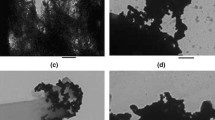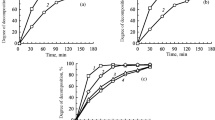Abstract
Electron spin resonance (ESR) spectrometry was used to study Cu(II) complexes with anionic surfactant compounds of the types that have been detected in sewage sludge or in the fulvic acid fraction of anaerobically-digested sewage sludge and found to resist biodegradation in the soil environment. The ESR spectra of frozen (77 °K), aqueous solutions of linear alkyl benzene sulfonates and fatty alcohol sulfate esters at Cu-ligand molar ratios ranging from 0.1 to 1 exhibited anisotropic patterns indicative of a d x 2−y 2 groundstate of Cu(II) bound into innersphere complexes with the ligands arranged in square planar coordination. Sulfonate-type surfactants, both in the acid and salt forms, appeared to complex Cu(II) more efficiently than ester sulfate-type surfactants. Conventional physical parameters calculated from the ESR spectra were consistent with fully oxygenated, 4 O-ligand binding sites for the Cu(II) ions and indicated the formation of similar unidentate or bidentate complexes between Cu(II) and the surfactants at any Cu/ligand molar ratio investigated. The spectral lineshapes and related parameters of the Cu(II)-anionic surfactant complexes, however, were not very similar to those observed previously for Cu(II)-sewage sludge FA complexes. It was concluded that anionic surfactants involved in Cu(II) complexation by sewage sludge or sewage sludge fulvic acid do not behave as isolated, independent ligands, but instead may participate as co-ligands with other O-containing functional groups and/or as moities incorporated into the fulvic acid structure.
We’re sorry, something doesn't seem to be working properly.
Please try refreshing the page. If that doesn't work, please contact support so we can address the problem.
Similar content being viewed by others
References
Holtzclaw, K. M. and Sposito, G.: 1978, Soil Sci. Sac. Am. J. 42, 607.
McEvoy, J. and Giger, W.: 1986, Environ. Sci. Technol. 20, 376.
Malklin, R. and Malström, B. G.: 1970, in F. F. Nord (ed.), Advances in enzymology, Interscience, New York. pp. 177–244.
Schaumberg, G. D., LeVesque, C. S., Sposito, G., and Lund, L. J.: 1980, J. Environ. Qual. 9, 297.
Schaumberg, G. D., Holtzclaw, K. M., and Sposito, G.: 1982, Soil Sci. Soc. Am. J. 46, 310.
Senesi, N. and Sposito, G.: 1984, Soil Sci. Soc. Am. J. 48, 1247.
Senesi, N., Bocian, D. F., and Sposito, G.: 1985, Soil Sci. Soc. Am. J. 49, 119.
Sposito, G., Holtzclaw, K. M., and LeVesque-Madore, C. S.: 1979, Soil Sci. Soc. Am. J. 43, 1148.
Sposito, G., Holtzclaw, K. M., and LeVesque, C. S.: 1981, Soil Sci. Soc. Am. J. 45, 465.
Sposito, G., Holtzclaw, K. M., LeVesque, C. S., and Johnston, C. T.: 1982, Soil Sci. Soc. Am. J. 46, 265.
Sposito, G., LeClaire, J. P., LeVesque, C. S., and Senesi, N.: 1984, Methodologies to Predict the Mobility and Availability of Hazardous Metals in Sludge-Amended Soils, Calif Water Resour. Center Contribution No. 189, University of California, Davis, CA.
Umezawa, K. and Yamabe, T.: 1972, Bull. Chem. Soc. Japan 45, 56.
Walker, F. A., Sigel, H., and McCormick, D. B.: 1972, Inorg. Chem. 11, 2756.
Author information
Authors and Affiliations
Rights and permissions
About this article
Cite this article
Senesi, N., Sposito, G. Copper(II) complexes with refractory anionic surfactants found in sewage sludge. Water Air Soil Pollut 35, 147–155 (1987). https://doi.org/10.1007/BF00183850
Received:
Revised:
Issue Date:
DOI: https://doi.org/10.1007/BF00183850




